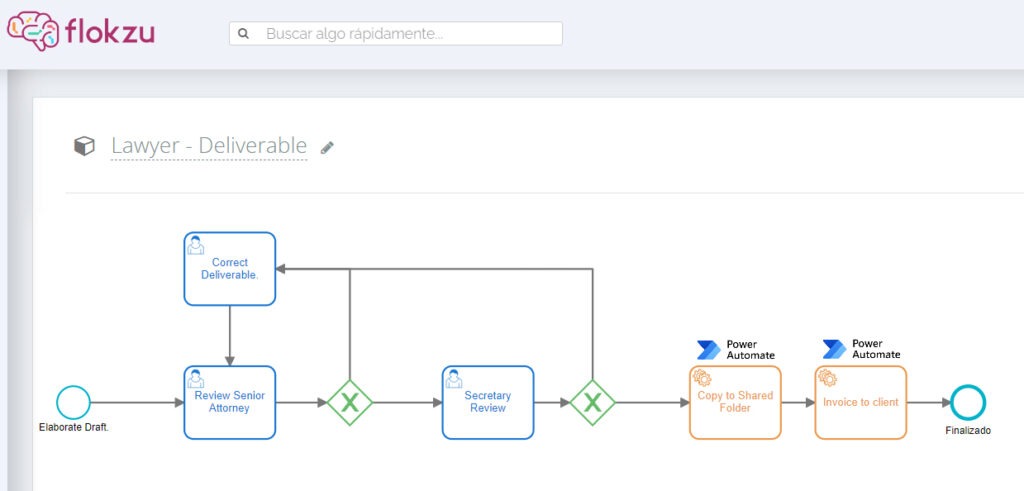Introduction
In this comparative analysis article, we will explore two prominent automation solutions: Flokzu and Microsoft Power Automate. Both offer distinct approaches with impactful results for optimizing business processes.
Flokzu stands out for its focus on end-to-end business process management, providing rich and meaningful human interaction. It’s like a conductor guiding every note of a process, ensuring a harmonious and effective execution.
On the other hand, Microsoft Power Automate excels in task automation, combining elements of Robotic Process Automation (RPA) and application integration functionalities (similar to Zapier, which, in fact, integrates with Flokzu). It excels in executing precise actions and logical sequences, creating a symphony of digital efficiency.
Power Automate: More RPA than BPM
This is a crucial distinction. Power Automate has its roots in task automation, playing the role of a choreographer for digital robots (RPA). Its strength lies in processes where actions can be performed by systems and applications, not necessarily by human hands.
Robotic Process Automation (RPA) is a technology that uses software to perform repetitive manual tasks in digital systems, emulating human interaction. This frees up employees to focus on more strategic and creative activities.
In contrast, Flokzu excels in business process management (BPM), automating processes that require human interaction. Think of Flokzu as the conductor of a symphony orchestra, where each member plays a crucial role in the melody of a business process.
Throughout this comparison, we will explore these differences and their impact on selecting the right tool for your specific needs.
Automation with Power Automate vs. Human Interaction with Flokzu
In the world of automation, these two great products stand out for their no-code approach. Flokzu and Microsoft Power Automate allow business professionals to create applications and automate processes without the need for programming knowledge or complex infrastructure configurations.
Flokzu: The Symphony of Human Interaction
Flokzu emerges as the champion of human interaction in business processes. Its no-code approach makes it easy for teams to create workflows that involve people intuitively and effectively. This is crucial in processes where collaboration and human decision-making are essential. Three concrete examples that help understand this definition are:
- Financial Document Approval Process: In this process, financial documents such as budgets, reports, and invoices require approval. Flokzu allows you to create a workflow where each approval stage is assigned to the corresponding person. Participants receive notifications to review and make decisions on the documents, maintaining a clear record of each step.
- Vacation Request: In work environments, having an effective system to request and manage vacations and absences is essential. Flokzu facilitates the creation of a workflow where employees can request time off, and supervisors can review and approve such requests. This establishes smooth communication and maintains an organized record of absences.
- Customer Claims: In this scenario, customers can file claims about products or services. Flokzu provides a workflow where these claims are logged, assigned to the relevant departments for review, and tracked until resolution. This ensures a quick and effective response to customer concerns.
Microsoft Power Automate: Eliminating Manual Tasks
On the other hand, Microsoft Power Automate excels in automating repetitive manual tasks and integrating with other systems. Through its no-code approach, it allows you to create automation sequences without the need for programming skills. It’s like a conductor coordinating digital robots in a precise and efficient execution of tasks. Three concrete examples that help understand this definition are:
- Automatic Database Updates: Imagine a company that collects sales data in a spreadsheet and needs it to be updated in a centralized database. Power Automate can schedule a robot to periodically extract data from the spreadsheet and automatically enter it into the database without human intervention.
- Approval of Small Expenses: When an employee submits a minor expense report, it needs approval. With Power Automate, a robot can be configured to receive and automatically review expense reports. If they meet the established criteria (including the amount), the robot approves them directly.
- Low Inventory Notifications Management: In a warehouse, it’s crucial to maintain an adequate inventory to prevent product shortages. Power Automate can be integrated with the inventory management system. When certain products reach low levels, the robot can automatically generate a purchase order and send it to the appropriate supplier without requiring human intervention.
The Power of No-Code: Streamlining Creation
Both products share a fundamental feature: the absence of code. This means that business analysts and managers can take the lead without relying on developers. Flokzu and Power Automate allow for quick implementation and adaptation to changing business needs.
However, this is where the differences shine. Flokzu specializes in processes where human interaction is at the heart of the workflow, while Power Automate excels in automating digital tasks where human intervention is minimal.
In summary, the no-code capability of both products is a catalyst for business agility, but they do not necessarily replace each other. This leads us to the next chapter…
Flokzu and Power Automate: Collaboration Instead of Competition
When it comes to automation, Flokzu and Power Automate are not rivals but allies in the pursuit of maximum operational efficiency. These tools not only coexist but also complement each other astonishingly, unlocking the potential for end-to-end process automation.
An Example of Use Case
Imagine a law firm that needs to draft, review, and send contracts to its clients. Flokzu becomes the essential tool to orchestrate this complex process from start to finish, and at certain stages, Power Automate allows you to automate manual tasks and integrate them with the firm’s ERP system. The following diagram in BPMN notation shows a highly simplified and illustrative process:

- Creation of the Contract: A Junior lawyer initiates the process in Flokzu, providing contract details such as involved parties, terms, and conditions.
- Review and Editing by a Senior Lawyer: The contract is assigned to senior lawyers for review. Each lawyer can provide comments and suggestions, ensuring effective collaboration. If something is not right, it can be sent back.
- Secretary Review: Once a consensus is reached, the contract is reviewed, and formatting, spelling, corporate identity, and the final version are corrected. Flokzu maintains a version history for future reference. If something is not right, it can be sent back.
- Integration with Power Automate: Power Automate is activated, and the final version is copied to a shared folder with the client. This task used to be done manually, consuming time and being prone to errors. Now, a robot handles it.
- Billing with the ERP: Finally, Power Automate integrates with the legal firm’s ERP system and generates an invoice for the client based on the hours spent on drafting the contract.
This process, which previously required multiple manual steps and possibly involved certain risks of errors, now runs efficiently and effortlessly. The integration between Flokzu and Power Automate is the key to this efficiency, allowing a seamless transition from drafting to billing.
This automation not only saves time and reduces the risk of errors but also frees up lawyers to focus on their legal expertise rather than administrative tasks. It’s a clear example of how technology can transform and improve processes in the legal world.
Limitations of Human Interaction in Power Automate
Although Microsoft Power Automate is an exceptional tool for digital task automation, it has limitations when it comes to processes that require significant human interaction, especially when those processes are complex and involve dozens (or hundreds) of tasks. These limitations are important to consider when contemplating the implementation of Power Automate in environments where collaboration among many users and teams is essential.
Complexity in Configuration
When intensive interaction with people is sought, Power Automate may require more complex and customized configurations. This involves more time and resources for implementation, which may not be feasible in situations with tight deadlines. Additionally, maintaining these complex configurations when changes are needed (and they will be!) can be expensive and require specialized personnel.
Custom Development
While Power Automate has no-code functionalities, for processes involving detailed and specific human interaction, custom development may be required. This adds an additional layer of complexity and can result in higher costs and longer timelines. Like in the previous case, it makes maintenance, evolution, and adaptation to future changes challenging.
Cost Overruns and Extended Timelines
Implementing complex human interactions in Power Automate can lead to cost overruns, especially if custom development is required. Moreover, implementation timelines can be extended, which may not be viable in situations that require an agile response.
Limitations in User Experience and Interface
Power Automate’s user interface is not specifically designed to facilitate complex human interaction. This can lead to a less intuitive and efficient experience for users participating in the process.
Conclusions
In this comparison between Flokzu and Microsoft Power Automate, we have explored their strengths, differences, and how they complement each other in various automation contexts. Flokzu excels in managing end-to-end business processes that can have dozens or hundreds of tasks and involve rich and meaningful human interaction. On the other hand, Power Automate shines in automating digital tasks and replacing manual activities performed by a digital robot.
Both tools share a vital feature: their no-code approach. This empowers business professionals to create applications and automate processes without programming skills, accelerating implementation and adaptation to changing business needs.
A simple yet highly illustrative example was presented, where Flokzu excels in managing a process from start to finish for the drafting and review of contracts in a legal firm. In this process, human interaction is essential, as is tracking different tasks and their deadlines. Collaboration with Power Automate enhances efficiency by allowing the copying of final documents to a shared folder and automated billing through integration with the firm’s ERP.
In conclusion, Flokzu and Power Automate are not direct competitors but powerful allies in business automation. Their no-code capability and specialized approaches combine to deliver effective solutions in a wide range of processes across all industries.




























